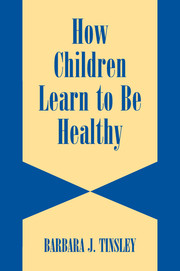Book contents
- Frontmatter
- Contents
- Acknowledgments
- How Children Learn to Be Healthy
- Introduction
- 1 Mechanisms and Consequences of Socializing Children to Be Healthy
- 2 Children's Health Understanding and Behavior
- 3 Parents' Health Beliefs
- 4 Parents' Promotion of Their Children's Health
- 5 Parents' Promotion of Their Children's Sexual Health
- 6 Peers, Schools, and Children's Health
- 7 How Television Viewing and Other Media Use Affect Children's Health
- 8 The Social Ecology of Children's Health Socialization
- 9 Summary and Conclusions
- References
- Index
7 - How Television Viewing and Other Media Use Affect Children's Health
Published online by Cambridge University Press: 27 July 2009
- Frontmatter
- Contents
- Acknowledgments
- How Children Learn to Be Healthy
- Introduction
- 1 Mechanisms and Consequences of Socializing Children to Be Healthy
- 2 Children's Health Understanding and Behavior
- 3 Parents' Health Beliefs
- 4 Parents' Promotion of Their Children's Health
- 5 Parents' Promotion of Their Children's Sexual Health
- 6 Peers, Schools, and Children's Health
- 7 How Television Viewing and Other Media Use Affect Children's Health
- 8 The Social Ecology of Children's Health Socialization
- 9 Summary and Conclusions
- References
- Index
Summary
Parents, schools, and peers are not the only influences on children's health; television viewing and other media use helps shape children's health attitudes and behavior (Anderson, Huston, Schmitt, Linebarger, & Wright, 2001). In an era when researchers, policymakers, and media industrialists are attempting to sort out the complex relations between children and mass media, the entire nature of media is undergoing dramatic change. The explosive growth of the Internet and computer technology, as well as access to these, is ushering in a new media culture that is being embraced wholeheartedly by children and adolescents (Montgomery, 2000). A recent survey of youths' use of all types of media (television, videotapes, movies, computers, video games, radio, compact discs, tape players, books, newspapers, magazines) suggests that children and adolescents are immersed in these media forms (Roberts, 2000). Most households contain most types of media, and the majority of youth own their own. The average American child devotes almost 7 hours per day to media use (Roberts, 2000). Television is the dominant form, although about one-half of children and adolescents use computers daily.
During an average year, an American child will watch a variety of events on television that have clear implications for health and health risk: almost 2,000 commercials for alcohol, more than 14,000 sexual references, and more than 1,000 murders, rapes, and assaults (Strasburger, 1989; Strasburger & Donnerstein, 2000; Strasburger & Hendrin, 1995).
- Type
- Chapter
- Information
- How Children Learn to be Healthy , pp. 83 - 103Publisher: Cambridge University PressPrint publication year: 2002



